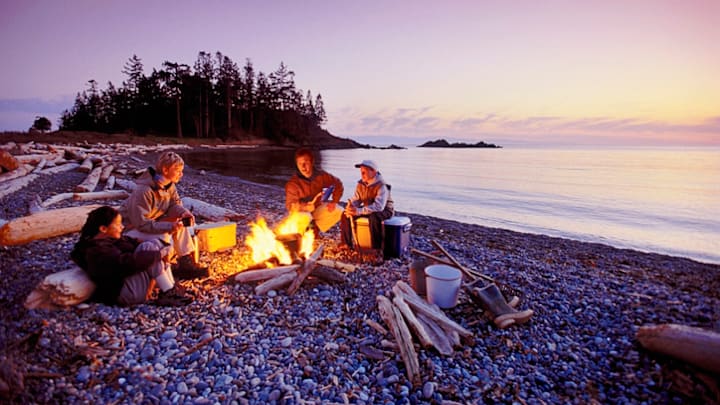Nothing transforms a night out in nature quite like a campfire. But as easy (in theory) as building a beautiful blaze might be, you may find yourself spending more time trying to get the wood to ignite than you do making s’mores.
Outdoor manuals, the U.S. Forest Service, and even Smokey the Bear offer several solutions to help simplify the campfire building process. Developed campgrounds make it even easier to build a fire: They often supply a metal fire ring so you don’t have to find and clear a safe area first. Here are six helpful hacks to light up your campfire game.
- Collect three sizes of wood.
- Have your wood organized before lighting your match.
- Build a tepee.
- Use a fire starter.
- Fan the flames.
- Be sure your fire is really out.
Collect three sizes of wood.

The 1967 Boy Scouts of America Fieldbook reminds campers that three groups of differently-sized sticks are needed to fuel a fire:
- Tinder is the smallest group and includes tiny twigs, dry leaves, or wood shavings that will be the initial fuel. Think of them as that flirty fluff ready to meet a lit match.
- Kindling is bigger sticks that will catch the flame from the tinder and increase the overall size of the fire.
- Logs are the largest size and give the campfire lasting life. In many campgrounds, you can collect wood from the ground—not live trees!—or buy local firewood that is certified free from invasive species.
Have your wood organized before lighting your match.

Not being ready to give your fire what it needs is nearly every outdoor newbie’s mistake. You want to have all of your fuel organized by size and within reach near the fire ring so you can build your fire quickly and in the right order [PDF]. Scouts start the fire with the driest, smallest materials first and layer up gradually with larger pieces. This way, you won’t be scrambling to keep it lit, and if you’re going to be at your campsite for a while, you might consider creating a tidy, close-at-hand woodyard.
Build a tepee.

For more bark in your flame’s bite, build a tepee with your wood. Place your most flammable material in the fire ring and lean small, thin twigs against it to form a conical tepee shape. Then stack a few pieces of kindling around your tinder teepee—making sure leave plenty of space for air to flow through—and finally, lean three logs together like a pyramid over the whole thing. Light the tinder and wait for the kindling to catch the flame, adding more kindling underneath the logs as the sticks burns, until the logs start to ignite.
Use a fire starter.

According to the Scout manual, birchbark is where it’s at for kickstarting a fire. “You will find it burns furiously, wet or dry. Many old-time campers carry a tiny roll of birchbark in their packs,” it claims.
If you don’t happen to be camping in an alpine forest, you can make a feather stick. Fire making guides note that taking a dry, dead stick and shaving it into curls produces effective incendiary ignition—the drier your wood, the better, but this works even in wetter zones. Use a knife to spiral-cut the stick, torch the tip, and drop it into your tinder. Old-school campers swear by using paraffin-soaked dryer lint, cotton balls coated in Vaseline or hand sanitizer, and even Doritos as fire starters.
Fan the flames.

Say you get your fire started with your tinder and are adding kindling to the mix, but then the flames sputter out, even though the coals are still glowing. The fire needs oxygen, stat. Here’s where a metal shovel or campsite spade can come in handy. Dig around in the coals to create more channels for air flow, and then fan that fire vigorously with a plate, piece of cardboard, or other flat object. The gusts of air act like fire CPR.
Be sure your fire is really out.

When the s’mores are eaten and it’s time to curl up in your sleeping bag, remember Smokey’s oft-shared mantra: “Only you can prevent forest fires.” Extinguish your campfire thoroughly by dousing it with water until the hissing stops, and stir the ashes with your shovel. Rinse and repeat until cold to the touch. Never bury or try to smother coals because they stay live under leaves or dirt. Do your fire right, and you’ll have a fun, relaxing evening that otherwise leaves no trace behind.
Discover More Adventure Tales and Tips:
